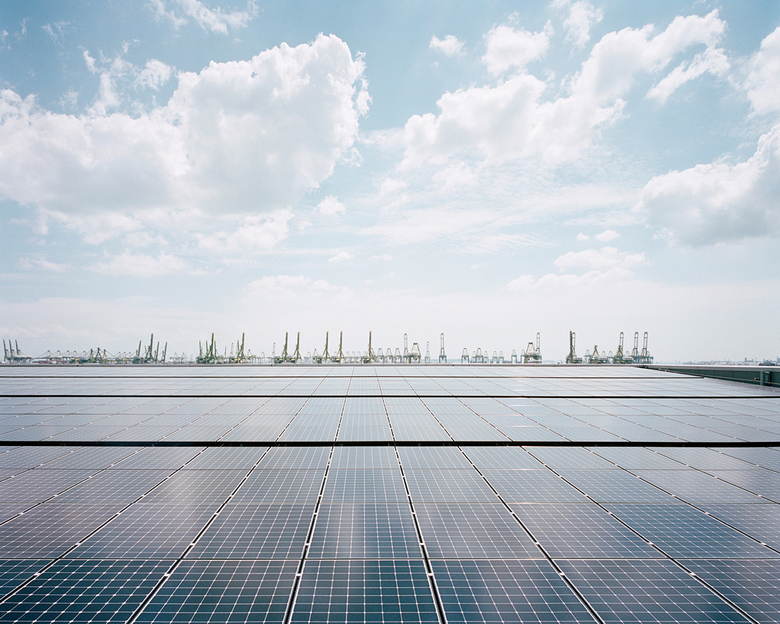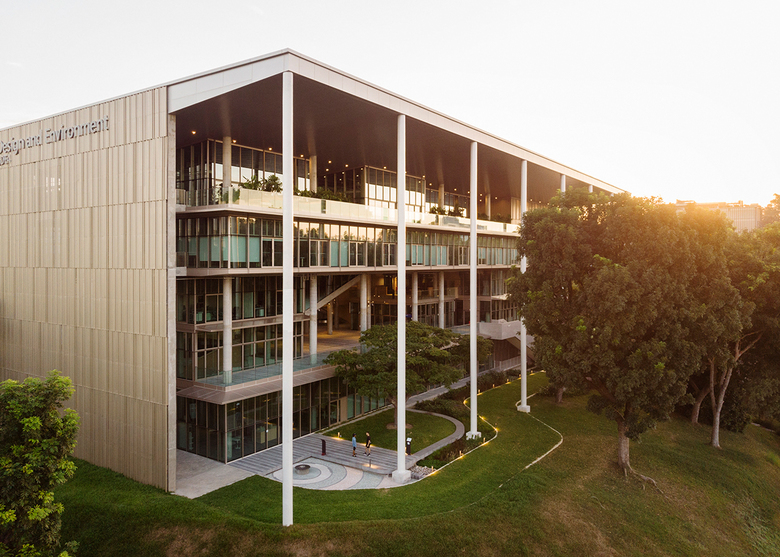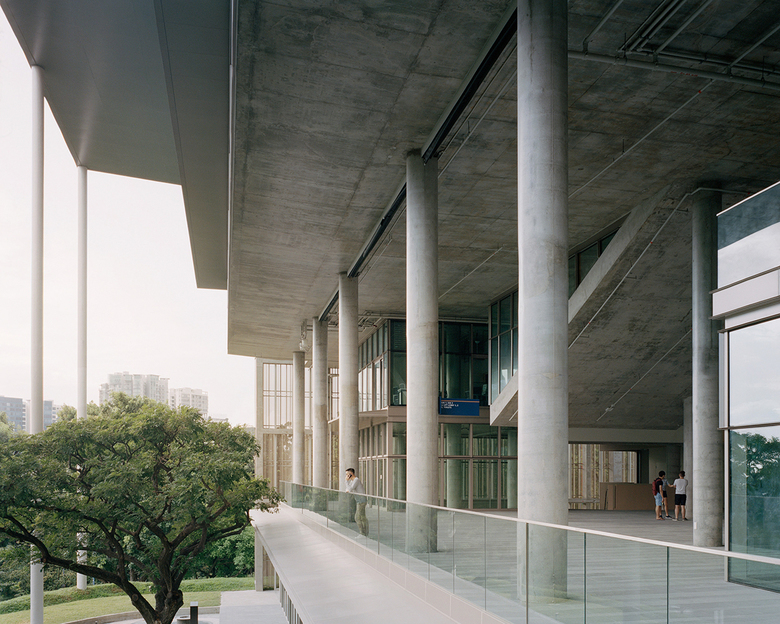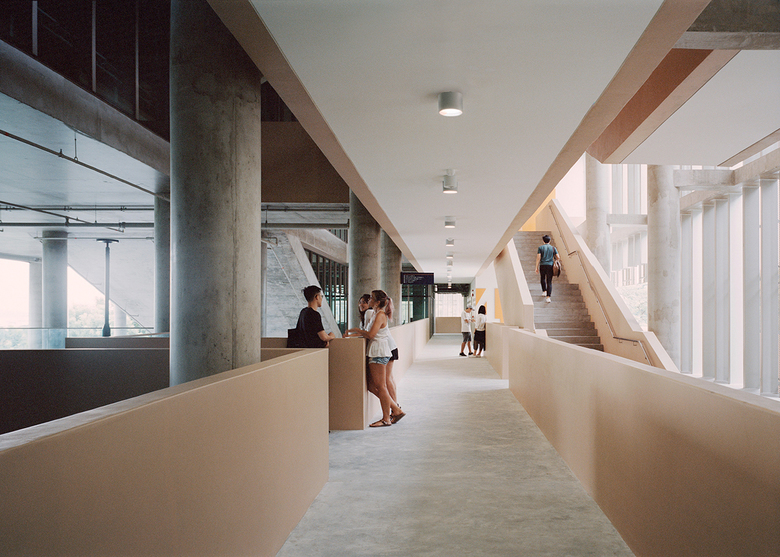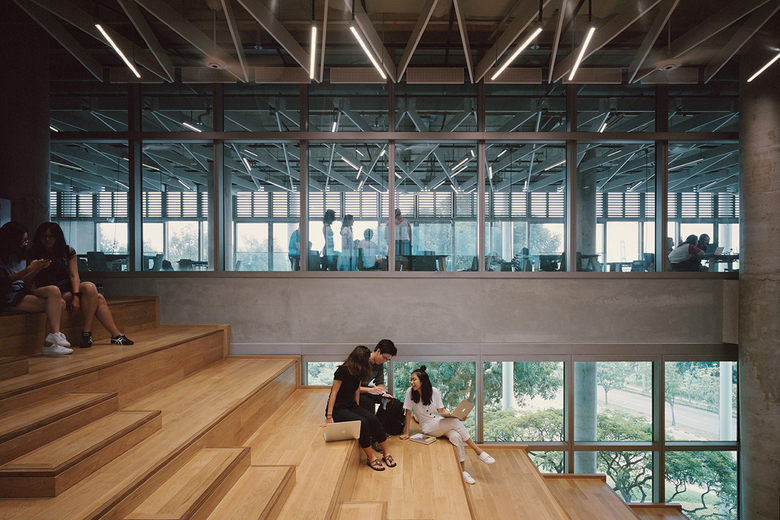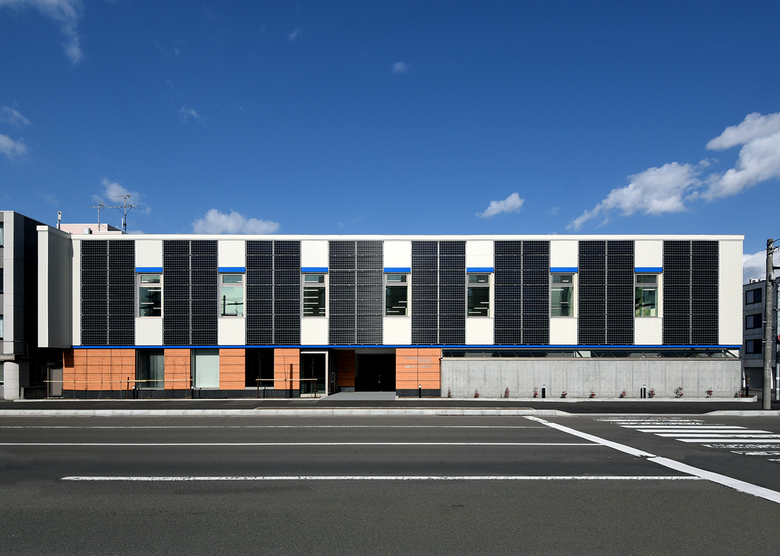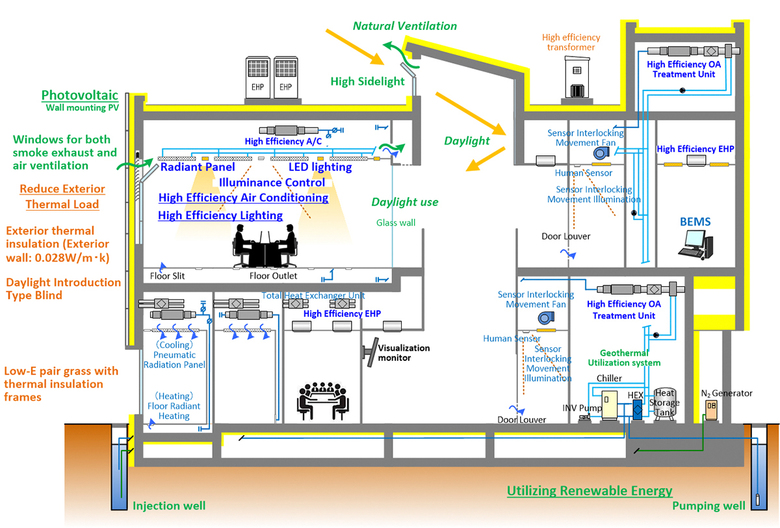Can Buildings Really Be ‘Plus Energy’?
Ulf Meyer
3. 7月 2019
Roof of SDE4 in Singapore (Photo: Rory Gardiner)
Two new buildings in East Asia — the School of Design and Environment at the National University of Singapore and Sanken's Branch Office in Sapporo, Japan — take very different approaches to finding an answer.
It seems like a logical next step: For many years architects and engineers reduced the energy demand of many buildings to around 100 kWh/m2a (kilowatt hours per square meter per annum), an arbitrary threshold that long entitled a building to be called “low-energy.” That achievement was a first step in the right direction, but soon the discussion circled around to the questions, “Why 100? Why not zero?” So recently some of the best architects and engineers have been developing concepts for “zero-energy buildings” (ZEBs). Even with mixed success some ambitious scientists, experts, and clients alike have started to raise the bar with the questions, ”Why zero? Why not ‘plus’?” So a new benchmark was born in the environmentally-friendly-building circles.
The goal of turning buildings not only into non-consumers, but net-producers of energy seems as reasonable as it is hard to achieve. In East Asia two very different buildings that test competing paths towards achieving “plus-energy” were recently inaugurated. Given the pressing global debate about climate change and dwindling resources in a rapidly urbanizing world, the two projects raise some relevant questions for the future of the built environment altogether. For instance, (how) can “ZEBs” and/or “plus-energy buildings” be produced by the millions in the future, and would that be desirable?
SDE4 in Singapore (Photo: Rory Gardiner)
Two case studiesWhile both are located in East Asia, the two most recent case studies of this exciting new trend in contemporary architecture are different in almost every way. One is a small office building in Japan’s cold, north-Asia climate zone, while the other is a large education building near the equator in Singapore’s hot and humid rainforest setting. The Japanese example works as a showcase and test bed for the engineering company that built it for its own use, doing so with more technical than architectural ambitions. The building in tropical Singapore, on the other hand, bets on low-to-no-tech means of achieving well-tempered learning environments; it is quite self-confident architecturally, with the goal of becoming a beacon for a new era of higher-education buildings.
SDE4 in Singapore (Photo: Rory Gardiner)
The SDE4 Building — porous and shallowTo tackle climate change, buildings need reduce to carbon emissions, a quarter of which in the city-state of Singapore stem from buildings and their ever-running air conditioners. The National University of Singapore (NUS), a high-ranking public university, launched Singapore's first “net-zero energy building” at and for its School of Design and Environment (SDE). “Net-zero energy” here means the building, called SDE4, produces more energy than it consumes over the course of a year — by harnessing plenty of solar energy and consuming very little of it. With an environmental concept developed by Transsolar, more than 1,200 solar photovoltaic panels power the building and produce more than 500MW hours of energy a year, equivalent to the annual energy consumption of about 110 four-room flats. This is not only ecologically advantageous, but also economical: The building will save S$180,000 in energy costs every year.
In Singapore the cooling of buildings typically accounts for 40 to 50 per cent of a building's energy consumption. SDE4’s public spaces were designed to maximize natural ventilation, while its hybrid cooling system mixes natural ventilation for the majority of spaces with air conditioning for small rooms at certain hours. However, the building's cooling system is designed as a single-pass system with no recirculated air, as it continuously supplies fresh air to building users.
SDE4 in Singapore (Photo: Rory Gardiner)
SDE4 was designed by Serie Architects from the UK, and Multiply Architects and Surbana Jurong from Singapore, with Japanese contractor Kajima. The building holds 400 students with most spaces used as design studios for the future generation of young architects. The design has a porous elevation and shallow plan, both allowing cross breezes and lots of natural light, reducing the need for artificial lighting. The boxes containing 8,500 m2 of floor space are arranged to be “floating,” meaning none of the wide hallways are conditioned. Big ceiling fans are used throughout the building. The deep roof overhang helps to shade the main façade and gather rainwater that goes to a beautifully designed tank where it then used for irrigation.
Hsieh Fu Hua, Chairman of NUS Board of Trustees, sees the SDE4 as a successful example of an “outcome when government, industry, and academia work together.” Singapore is known for its unique mix of a high-performance free-market economy and a rather authoritarian government that is very active in the housing and urban design realms. The powerful HDB (Housing and Development Board) is closely watching experimental buildings such as the SDE4 to see if they will introduce some of its thinking and features into HDB’s giant housing stock, which is home to four out of five Singaporean residents. SDE4 could all of a sudden gain an enormous significance and scale effect.
SDE4 in Singapore (Photo: Rory Gardiner)
The cold north of East AsiaIn Sapporo, the biggest city on Japan’s northernmost main island of Hokkaido, another interesting example of a next-generation low-energy building just started operations: Branch Office Building for the Sanken Corporation, Japan’s leading HVAC consultancy. Sanken Setsubi Kogyo, as the company is known, also offers, installs, and maintains water supply, drainage, and sanitation systems; it designs, constructs, and maintains for the semiconductor, pharmaceutical, food, medical care, and manufacturing industries. So any new idea tested in its Sapporo Branch Building and proven to work could immediately find a wide application in the company’s portfolio of buildings and projects. The building with 1,900 m2 is a reinforced concrete structure with two floors, located just north of Sapporo’s main train station. It aims for energy saving feature for ZEB in cold climates, but also for comfortable office workplaces and earthquake resistance.
Sanken Branch Office in Japan (Photo courtesy of Sanken)
The southern façade is clad with 112 PV-panels with a performance of 240 W each. The BIPV (building integrated photovoltaics) also gives the building a distinct aesthetic, since the new black thin-film panels have become quite attractive architecturally. The windows have external blinds that automatically adjust to the sun’s altitude and to wind speed. Especially important in the long cold winter months in Japan’s northernmost prefecture is the thermal insulation. Sanken installed 100mm insulation (heat conductivity of 0.028W/m*K) all around the building including against the ground. The windows are low-e glass (thermal transmittance of 1.4 W/m2*K) with insulated frames. For Japan, where there is no tradition of designing buildings for minimal winter heat loss, so these are great numbers.
Architecturally, the central atrium is the most prominent feature. It uses stack ventilation and the so-called chimney effect, making it possible for outside air to be used in lieu of air conditioning, which is switched off automatically in summer as conditions allow it. High-performance radiant heating panels were installed in the ceiling, with the heat taken from a geothermal source. All lights are LED and sensor-controlled, of course. Since energy consumption is such an abstract and invisible phenomenon, a clever monitoring system was installed that allows users to monitor and adapt their behavior accordingly in terms of building and energy use. All of these features, including the building itself, were designed by the staff of Sanken.
Sanken Branch Office in Japan (Photo courtesy of Sanken)
Sanken was founded in 1946 to provide HVAC, plumbing and sanitation for office buildings, hospitals, high-rise condominiums, leisure facilities and cleanrooms. To meet zero energy building (ZEB) guidelines, Sanken has been developing radiant and ground-source cooling since the 2000s. In 2014, Sanken had already retrofitted their R&D facility, the Tsukuba-Mirai Technology Center near Tokyo, to meet ZEB performance criteria. The building received the sixth Sustainable Building Award from Japan’s Institute for Building Environment and Energy Conservation and the Minister of Environment Award. To test and demonstrate their ZEB capabilities in a cold climate, Sanken built their Branch Office. With an annual mean temperature of 10ºC in Sapporo, the new office features a whole bundle of energy-conservation technologies. The building attained the “ZEB Ready” evaluation of the BELS certification, issued by the Board of Editors in the Life Sciences (BELS).
Sanken Branch Office in Japan (Drawing courtesy of Sanken)
In Singapore and Japan different routes towards zero-energy and ultimately plus-energy buildings are being tested. These projects require close monitoring and unbiased evaluations if the goal of finding a new, less harmful architecture for a planet encountering climate change is to be achieved.
関連した記事
-
Can Buildings Really Be ‘Plus Energy’?
on 2019/07/03
